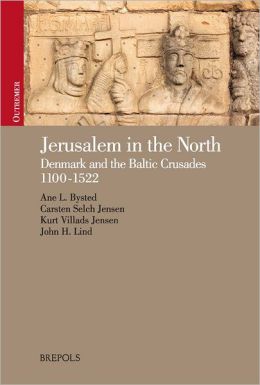A. Bysted, K. V. Jensen, C.S. Jensen, J. Lind (eds.)
Jerusalem in the North: Denmark and the Baltic Crusades, 1100-1522
Outremer. Studies in the Crusades and the Latin East 1 (Turnhout, Belg.: Brepols, 2012). xiv+393pp. ISBN: 978-2-503-52325-5.

It may come as a bit of a shock and a surprise to many readers that Denmark had such a pivotal role in the realm of the Crusades, given the small population base of Denmark and its reputation in recent centuries for being a small and inwardly-directed state. This particular work, however, manages to discover impressive historical documentation from a wide variety of sources ranging from Norse sagas to Russian histories to the letters of the papal curia to demonstrate the importance of Danish efforts to crusades in the Baltic region and further afield. This evidence demonstrates beyond the shadow of a doubt that Denmark was not only involved in crusades, but pivotally important in providing a balance against other powers in the region for a lengthy period of time. This is all the more surprising, as this was a period of time when Denmark suffered extensive civil disorder and lacked a recognized king, as the entire kingdom had been mortgaged away to German nobles.
As this work is a history of the Crusades, there is a great deal of religious history included, involving papal politics, frequent rivalries between church and state in Denmark and elsewhere (especially Estonia and Livonia), and religious and geopolitical motives of various nations and feudal institutions. However, there is a great deal of military history to be found here, whether it involves a discussion of alliances, military technology (including fortresses and siege equipment as well as ordinary weapons and armor), battles, grand strategies, the justification of war, taxation, and other related affairs. Of particular interest to the authors is a comparison between Denmark, Sweden, and Germany: Sweden had a more sustainable imperial model by virtue of the equality between Finnish and Swedish peasantry; Germany had a more sustainable model by virtue of its demographic strength in being able to provide colonists to change the population of Wendish [i.e., west Salvic] and Baltic areas; Denmark lacked the strength of both of its main imperial rivals in the Baltic. The authors use these factors as an explanation for Denmark’s eventual failure to maintain its power in the Baltic region despite its lengthy effort and considerable crusading fervor as well as several brave and ambitious rulers.
It is unlikely that many readers will have a profound knowledge of either the Baltic Crusades, except perhaps a few of its more famous engagements or some knowledge of the Teutonic Order. It is even more likely that most of the potential readers of this well-researched work have little understanding of Danish history. However, it appears that the authors of this work have sought to help readers understand matters better through the frequent use of translations for place names between Danish, German, Swedish, Russian, Finnish, and Estonian. They have included sidebars to explain matters of literary interest, such as the ambiguity of the term “Finn” in some of the primary sources, which first referred to the Lapp peoples and then around 1200 or so started to refer to the Suomi people and their ethnic cousins (those peoples who are considered Finns nowadays). There are also maps and genealogical tables to help put many of the more important people and locations into their proper context and place. These aids greatly help in making the history of Denmark and its lengthy imperial and crusading forays into the Baltic region more comprehensible.
Overall, the book is clear, easy to read, and filled with a great deal of little-known information about an area of medieval history that is of considerable importance in broadening our understanding of the lasting effects of the Crusades. The problems that resulted from Russian and German imperialism in Eastern Europe that greatly shaped the twentieth century have antecedents that go long before, into the Middle Ages. This book manages to show how Danish, German, Swedish, Russian, and Polish efforts at imperialism ended up having a dramatic effect on the map of Europe and on present conditions, whether one examines the existence of Danish-language place names in modern Finland, or the fact that Estonia’s capital [Tallinn – this is apparently debated. Ed.] actually means “the Danish fortress” (p. 148), or the destruction and assimilation of the Wendish and Prussian peoples into later German and Danish territories. Even the existence of the Lithuanians as a group appears to have been due to the pressures of imperialism by the Danes and Germans (and to a lesser extent, the Poles), which forced small pagan Slavic tribes to unite together or face destruction at the hand of fierce Crusading armies. The authors of this work deserve credit for managing to tie together such a wide variety of sources together in order to tell the story of Danish involvement in the crusades and its greater involvement in matters as wide-ranging as the Hanseatic League and Russian dynastic politics. The result is a complicated and deeply nuanced work that rewards careful study and provides information that is both largely unknown to a wide audience as well as surprisingly relevant to the wider medieval world as well as more modern considerations.
